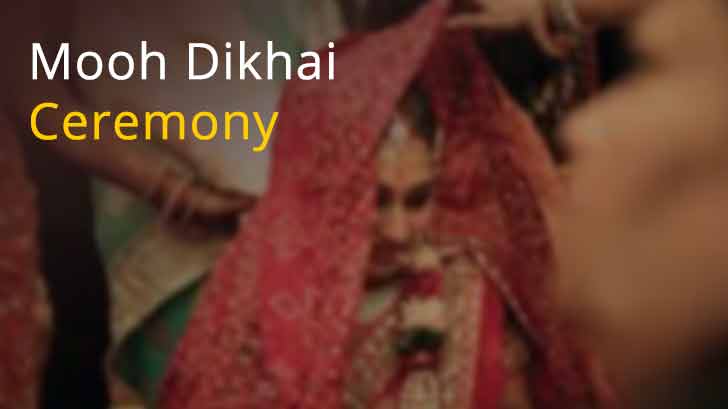-
Customer Care 9999 091 091
- Consult Now
-
Notifications
-

An important post-wedding ritual for the bride is the Mooh Dikhai Ceremony or the Mooh Dikhai ki Rasam, which means ‘showing your face’ and in this context unveiling your bridal veil.
The Mooh Dikhai Ceremony comes right after the Griha Pravesh Ceremony in Hindu weddings in India. In Indian weddings the hectic days of the wedding day may get over but not the rituals and their celebrations. The bride, in particular, has to perform many important traditional rituals in her new home. The mother-in-law of the bride and other ladies unveil the face of the bride and shower her with some lovely gifts. Its basic purpose is to welcome the bride in a great manner, introducing her to her new extended family and relatives, and to also enjoy the new relationship in the life of every family member.
India is such a diverse country where weddings and rituals are performed differently from each other across cultures and so is the case with the Mooh Dikhai Ceremony. But, the essence of the ceremony remains the same everywhere of welcoming and introducing the bride to her new family members in a grand manner.
Want to know about your married life? "Talk to an Astrologer for marriage & kundli consultation
The most common way of celebrating the Mooh Dikhai is by making the bride sit with her face covered with her bridal veil or Ghoonghat. The mother-in-law and other ladies of the groom’s family lift the bride’s veil one by one and offer gifts to the bride for showing her face thus welcoming her to the family.
The bride is introduced to all family members and relatives of the groom’s family and each member offers the bride some gift or the other as a welcome gesture. The gifts can be things like ancestral jewelry (particularly from the bride’s mother-in-law), holy book, clothes, money, or other useful things. These gifts are considered as shagun in India.
Besides, the bride also seeks everyone’s blessings. Later on, the groom’s family goes on to play some light-hearted and fun-filled welcoming games with the bride to let her arrival be on a cheerful note.
In earlier days, the baraat (groom’s wedding procession) traveled by horse or by walk to the bride’s place to get married and bring her along with him. As the travel might be hectic, women members would usually stay back without participating in the baraat and wait till the Mooh Dikhai Rasam to see the bride. So, this was considered to be an important ceremony being the first chance for all women relatives of the groom to meet up with the bride.
Grooms may also offer his newly wedded wife with gifts in the form of jewelry, etc. on the ‘first night’ or popularly known as "suhaag raat" together after she has lifted her bridal veil in front of her husband.
The significance of the Mooh Dikhai Rasam is that it is a kind gesture from the groom's family to show respect towards their new family member - the bride - by giving her a warm welcome and celebrating the onset of a new relationship. This occasion also enables the bride to get familiar with the friends and family members of her husband, so that she can get along with them and feel comfortable in their presence.
This post-wedding ceremony is an opportunity for all the family members of the groom to get acquainted with the new family member and strengthen their bond with her for the years to come. Be it the Mooh Dikhai Ceremony or any other Hindu wedding ritual, indeed, they are a feast to one’s eyes.